Chapter 11 Study of Animal Type: Cockroach
Question (A)
Chemical nature of chitin is ____________ .
(A) protein
(B) carbohydrate
(C) lipid
(D) glycoprotein
Answer:
(B) carbohydrate & (D) glycoprotein
Question (B)
Cockroach has ___________ type of mouthparts.
(A) sponging
(B) chewing and biting
(C) piercing and sucking
(D) lapping
Answer:
(B) chewing and biting
Question (C)
Spiracle is a part of ________ system of cockroach.
(A) circulatory
(B) respiration
(C) reproductive
(D) nervous
Answer:
(B) respiration
Question (D)
________ is a part of digestive system.
(A) Trachea
(B) Hypopharynx
(C) Haemocyte
(D) Seminal vesicle
Answer:
(B) Hypopharynx
Question (E)
_________ is also called as brain of cockroach.
(A) Supra-oesophageal ganglion
(B) Sub-oesophageal ganglion
(C) Hypo-cerebral ganglion
(D) Thoracic ganglion
Answer:
(A) Supra-oesophageal ganglion
2. Answer the following questions
Question (A)
Describe the digestive system of cockroach.
OR
With the help of neat and labelled diagram, describe the digestive system of cockroach.
Answer:
1. Digestive system of cockroach consists of mouthparts, alimentary canal and salivary glands.
2. Mouthparts: Pre-oral cavity present in front of the mouth receives food. It is bounded by chewing and biting type of mouth parts.
These are movable, segmented appendages that help in ingestion of food. The mouthparts of cockroach comprises of:
(a) Labrum: It forms the upper lip. It is a single flap-like movable part which covers the mouth from upper side. It forms an anterior wall of pre¬oral cavity.
Function: It is useful in holding the food during feeding.
(b) Mandibles: These are two dark, hard, chitinous structures with serrated median margins.They are true jaws present on either side, behind the labrum.
Function: They perform co-ordinated side-wise movements with the help of adductor and abductor muscles to cut and crush the food.
(c) Maxillae: These are the accesssory jaws. They are also called as first pair of maxillae. These are situated on the either side of mouth behind the mandibles. Each maxilla consists of sclerites like cardo, stipes, galea, lacinia and maxillary palps.
Functions: Maxillae hold food, help mandibles for mastication. They are also used for cleaning the antennae and front legs. Maxillary palps act as tactile organs.
(d) Labium: It forms the lower lip. Labium is also known as second maxilla which covers the pre-oral cavity from the ventral side. It is firmly attached to the posterior part of head. It has three jointed labial palps which are sensory in function.
Function: It is useful in pushing the chewed food in the pre-oral cavity. It prevents the loss of food falling from the mandibles, while chewing.
(e) Hypopharynx: Hypopharynx is also known as lingua. It is a somewhat cylindrical single structure, located in front of the labium and between first maxillae. The salivary duct opens at the base of hypopharynx. Hypopharynx bears comb-like plates called super-lingua on either side. Hypopharynx is present at the centre of the mouth.
Function: It is useful in the process of feeding and mixing saliva with food.
3. Alimentary canal: It is long a (6 – 7cm) tube of different diameters with two openings.
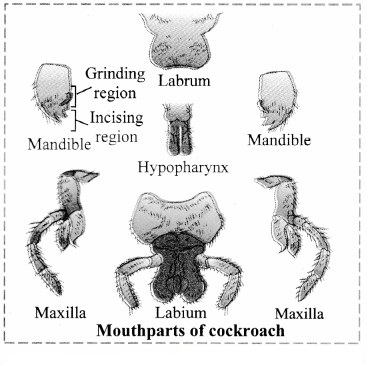
4. The alimentary canal is divisible into three parts: foregut, midgut and hindgut
(a) Foregut or stomodaeum: It consists of pharynx, oesophagus, crop and gizzard.
1. Pharynx: It is very short, narrow but muscular tube that opens into oesophagus.
Function: Conduction of food into the oesophagus.
2. Oesophagus: It is slightly long and narrow tube which opens into crop.
3. Crop: Crop is a large, pear shaped and sac- like organ.
Function: It temporarily stores the food and then sends it to gizzard.
4. Gizzard: Gizzard or proventricuius is a small spherical organ. It is provided internally with a circlet of six chitinous teeth and backwardly directed bristles.The foregut ends with gizzard.
Function: The chitinous teeth present in gizzard are responsible for crushing the food and the bristles help to filter the food.
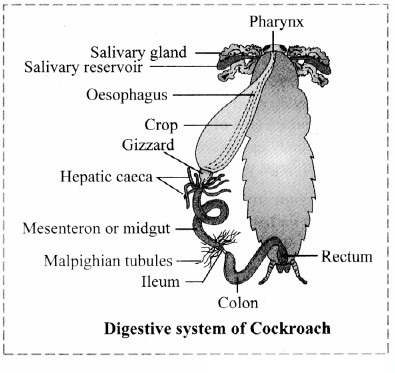
(b) Midgut or mesenteron: It consists of stomach and hepatic caeca.
1. Ventriculus or stomach: It is straight, short and narrow. Stomach is lined by glandular epithelium which secretes digestive enzymes.
Function: It is mainly responsible for digestion and absorption.
2. Hepatic caeca: These are thin, transparent, short, blind (closed) and hollow tubules.
Function: They secrete digestive enzymes.
(c) Hindgut or proctodaeum : It consists of ileum, colon and rectum.
1 Ileum: It is short and narrow part of hindgut. Malpighian tubules open in the anterior lumen of ileum, near the junction of midgut and hindgut. Posterior region of ileum contains sphincter.
Ileum directs the nitrogenous wastes and undigested food towards colon.
2. Colon: It is a longer and wider part of the hindgut. It directs waste material towards the rectum. It reabsorbs water from wastes as per the need.
3. Rectum: It is oval or spindle-shaped, terminal part of the hindgut. It contains six rectal pads along the internal surface for absorption of water. Rectum opens into anus. Anus is present on the ventral side of the 10th segment. It is the last or posterior opening of the digestive system. The undigested food is released out of the body through anus.
5. Salivary glands:
a. Cockroach has a pair of salivary glands which secrete saliva.
b. Each salivary gland has two glandular lobes and a receptacle or reservoir.
c. The glandular lobes consists of several irregular-shaped white coloured lobules which secrete saliva.
d. Each gland has a salivary duct.
Both the ducts unite to form a common salivary duct.
e. Receptacle of each salivary gland is thin-walled, elongated, sac-like structure. Each receptacle has a duct. These ducts unite to form common reservoir duct.
f. Common salivary duct and common reservoir duct unite together to form a common efferent salivary duct. The efferent salivary duct opens at the base of tongue or hypopharynx.
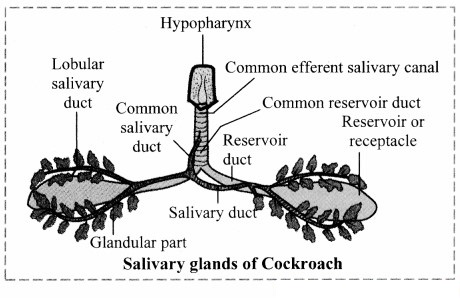
Question (B)
Give an account on tracheal system of cockroach.
Answer:
1. Cockroach has an internal respiratory system of air tubes called tracheal system by which the air is brought into the body and is in contact with every part of the body. It allows the exchange of gases directly between the air and tissues without the need of blood.
These air tubes of internal respiratory system begin at the opening on body surface called spiracles.
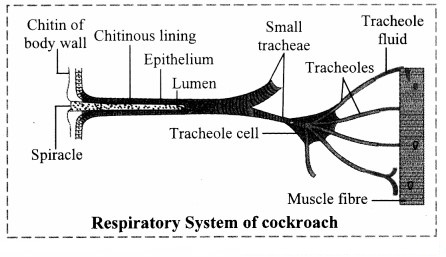
2. Spiracles: They are paired respiratory openings. Spiracles are present on the ventro-lateral side of the body, in pleural membrane. Cockroaches have two pairs of thoracic and eight pairs of abdominal spiracles.The spiracles open into a series of air sacs from which arise the tubes called trachea. The spiracles let the air into and out of trachea.
3. Trachea: The trachea form a definite pattern of branching tubes arranged transversely as well as longitudinally. They are about 1mm thick and have spiral or annular thickening of chitin. The inner lining of chitin prevents the trachea from collapsing. Each trachea further branches into smaller tubes called tracheoles.
4. Tracheoles: These are fine intracellular tubes that penetrate deep into tissues. They are thin and not lined by chitin. They end blindly in the cells. Each tracheole at the blind end is filled with a watery fluid through which exchange of gases takes place. The content of this fluid keeps changing. At high muscular activity, part of fluid part is drawn into the tissues to enable more and rapid oxygen intake.
Question (C)
Describe the nervous system of cockroach.
Answer:
Nervous system in cockroach:
Nervous system of cockroach is ventral, solid and ganglionated. It consists of central nervous system (CNS), peripheral nervous system (PNS) and autonomous nervous system (ANS).
Central nervous system (CNS): Central nerv ous system consists of nerve ring and ventral nerve cord.
1. Nerve ring consists of:
a. a pair of supra-oesophageal ganglia
b. a pair of circum-oesophageal connectives
c. a pair of sub-oesophageal ganglia
(a) Supra-oesophageal ganglia or cerebral ganglia: A pair of supra-oesophageal ganglia is collectively known as the brain. Brain is present in head, above the oesophagus and between antennal bases. Each supra-oesophageal ganglion is formed by the fusion of three small ganglia – protocerebram, deutocerebrum and tritocerebrum.
(b) Circum-oesophageal connectives: Supra-oesophageal ganglia are connected to sub-oesophageal ganglion by a pair of lateral nerves called as circum-oesophageal connectives. Connectives arise from supra-oesophagial ganglia.
(c) Sub-oesophageal ganglia: It is a bilobed and present below the oesophagus, in head. It is also formed by the fusion of three pairs of ganglia.
2. Ventral nerve cord:
a. It arises from the sub-oesophageal ganglion. It is present along mid-ventral position, in perineural sinus.
b. It is double ventral nerve cord and consists of nine segmental, paired ganglia.
c. First three pairs of segmental ganglia are large and known as thoracic ganglia. The other six pairs of segmental ganglia are in abdomen (abdominal ganglia).
d. 6th abdominal ganglion is the largest and it is present in 7th abdominal segment.
e. There is no ganglion in 6th segment.
Peripheral nervous system (PNS):
- The peripheral nervous system comprises of nerves that arise from various ganglia of CNS.
- Six pairs of nerves arise from the supra-oesophageal ganglia.They supply to the eyes, antenna and labrum.
- Nerves arising from the sub-oesophageal ganglion supply to the mandibles, maxillae and labium.
- Nerves arising from the thoracic ganglia supply to the wings, legs and internal thoracic organs.
- Nerves from abdominal ganglia go to the abdominal organs of respective abdominal segments.
- Autonomic nervous system (ANS): It consists of four ganglia and a retrocerebral complex.
The ganglia are as follows:
- Frontal ganglion: It is present above the pharynx and in front of brain.
- Hypocerebral ganglion: It is present on the anterior region of oesophagus.
- Ingluvial ganglion: It is present on crop. It is also called as visceral ganglion.
- Ventricular ganglion: It is present on gizzard.
Question (D)
With the help of neat labelled diagram, describe female reproductive system of cockroach.
Answer:

- Female reproductive system of cockroach consists a pair of ovaries, a pair of oviducts, vagina, spermatheca and accessory glands.
- Ovaries are primary reproductive organs. They are paired and lie lateral in position in 2nd – 6lh abdominal segments. Each ovary is formed of a group of 8 ovarian tubules or ovarioles, containing a chain of developing ova. All ovarioles of an ovary open in lateral oviduct of respective side.
-
The lateral oviducts unite to form a common oviduct or vagina.
Common oviduct or vagina opens into the Bursa copulatrix (genital chamber), the female organ of copulation. - Spermatheca, is a sperm storing structure present in the 6th segment opens into genital chamber. It receives the sperms during copulation and store them for fertilization.
- Collaterial glands are accessory paired glands that open in genital chamber.
- Female gonapophyses consists of six chitinous plates surrounding the genital pore.
- In males, genital pouch or genital chamber lies at the hind end of abdomen which is bounded dorsally by 9th and 10th terga and ventrally b; male genital pore and gonapophysis.
Question (E)
Draw a labelled diagram of digestive system of a cockroach.
Answer:
1. Digestive system of cockroach consists of mouthparts, alimentary canal and salivary glands.
2. Mouthparts: Pre-oral cavity present in front of the mouth receives food. It is bounded by chewing and biting type of mouth parts.
These are movable, segmented appendages that help in ingestion of food. The mouthparts of cockroach comprises of:
(a) Labrum: It forms the upper lip. It is a single flap-like movable part which covers the mouth from upper side. It forms an anterior wall of pre¬oral cavity.
Function: It is useful in holding the food during feeding.
(b) Mandibles: These are two dark, hard, chitinous structures with serrated median margins.They are true jaws present on either side, behind the labrum.
Function: They perform co-ordinated side-wise movements with the help of adductor and abductor muscles to cut and crush the food.
(c) Maxillae: These are the accesssory jaws. They are also called as first pair of maxillae. These are situated on the either side of mouth behind the mandibles. Each maxilla consists of sclerites like cardo, stipes, galea, lacinia and maxillary palps.
Functions: Maxillae hold food, help mandibles for mastication. They are also used for cleaning the antennae and front legs. Maxillary palps act as tactile organs.
(d) Labium: It forms the lower lip. Labium is also known as second maxilla which covers the pre-oral cavity from the ventral side. It is firmly attached to the posterior part of head. It has three jointed labial palps which are sensory in function.
Function: It is useful in pushing the chewed food in the pre-oral cavity. It prevents the loss of food falling from the mandibles, while chewing.
(e) Hypopharynx: Hypopharynx is also known as lingua. It is a somewhat cylindrical single structure, located in front of the labium and between first maxillae. The salivary duct opens at the base of hypopharynx. Hypopharynx bears comb-like plates called super-lingua on either side. Hypopharynx is present at the centre of the mouth.
Function: It is useful in the process of feeding and mixing saliva with food,
3. Alimentary canal: It is long a (6 – 7cm) tube of different diameters with two openings.
4. The alimentary canal is into three parts: foregut, midgut and hindgut
(a) Foregut or stomodaeum: It consists of pharynx, oesophagus, crop and gizzard.
1. Pharynx: It is very short, narrow but muscular tube that opens into oesophagus.
Function: Conduction of food into the oesophagus.
2. Oesophagus: It is slightly long and narrow tube which opens into crop.
3. Crop: Crop is a large, pear shaped and sac- like organ.
Function: It temporarily stores the food and then sends it to gizzard.
4. Gizzard: Gizzard or proventricuius is a small spherical organ. It is provided internally with a circlet of six chitinous teeth and backwardly directed bristles.The foregut ends with gizzard.
Function: The chitinous teeth present in gizzard are responsible for crushing the food and the bristles help to filter the food.
(b) Midgut or mesenteron: It consists of stomach and hepatic caeca.
1. Ventriculus or stomach: It is straight, short and narrow. Stomach is lined by glandular epithelium which secretes digestive enzymes.
Function: It is mainly responsible for digestion and absorption.
2. Hepatic caeca: These are thin, transparent, short, blind (closed) and hollow tubules.
Function: They secrete digestive enzymes.
(c) Hindgut or proctodaeum : It consists of ileum, colon and rectum.
1 Ileum: It is short and narrow part of hindgut. Malpighian tubules open in the anterior lumen of ileum, near the junction of midgut and hindgut. Posterior region of ileum contains sphincter.
Ileum directs the nitrogenous wastes and undigested food towards colon.
2. Colon: It is a longer and wider part of the hindgut. It directs waste material towards the rectum. It reabsorbs water from wastes as per the need.
3. Rectum: It is oval or spindle-shaped, terminal part of the hindgut. It contains six rectal pads along the internal surface for absorption of water. Rectum opens into anus. Anus is present on the ventral side of the 10th segment. It is the last or posterior opening of the digestive system. The undigested food is released out of the body through anus.
5. Salivary glands:
a. Cockroach has a pair of salivary glands which secrete saliva.
b. Each salivary gland has two glandular lobes and a receptacle or reservoir.
c. The glandular lobes consists of several irregular-shaped white coloured lobules which secrete saliva.
d. Each gland has a salivary duct.
Both the ducts unite to form a common salivary duct.
e. Receptacle of each salivary gland is thin-walled, elongated, sac-like structure. Each receptacle has a duct. These ducts unite to form common reservoir duct.
f. Common salivary duct and common reservoir duct unite together to form a common efferent salivary duct. The efferent salivary duct opens at the base of tongue or hypopharynx.
Question (F)
A student observed that the cockroaches are killed for dissection by simply putting them in soap water. He inquired whether soap is so poisonous. Teacher said it is due to its peculiar respiratory system. How?
Answer:
Cockroaches when put in soap solution, the solution enters into their body through the small respiratory openings called spiracles. The spiracles lead to trachea which further branches into smaller tubes called tracheoles. Each of these tracheoles has body fluid which acts as a stationary medium for diffusion. The soap solution rapidly diffuses through the entire respiratory system which may result in suffocation and eventually lead to the death of cockroach.
Question (G)
Describe the circulatory system of cockroach.
Answer:
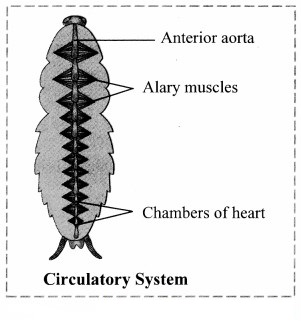
1. Haemolymph: Haemolymph is colourless as it is without any pigment. It consists of plasma and seven types of blood cells/haemocytes. Plasma consists of water with some dissolved organic and inorganic solutes. It is rich in nutrients and nitrogenous wastes like uric acid.Cockroach has open circulatory system. It consists of colourless blood (haemolymph), a dorsal blood vessel (heart and dorsal aorta) and haemocoel.
2. Haemocoel: The body cavity of cockroach (haemocoel) can be divided into three sinuses due to two diaphragms i.e. dorsal and ventral diaphragm. These diaphragms are thin, fibromuscular septa (sing.septum)
which remain attached to terga along lateral sides at intermittent points.
(a) Dorsal diaphragm: It has 12 pairs (10 abdominal and 2 thoracic) of fan-like alary muscles. Alary muscles are triangular with pointed end attached to terga at lateral side and broad end lies between the heart and dorsal diaphragm.
(b) Ventral diaphragm: It is flat and present just above the ventral nerve cord. Laterally, it is attached to sterna at intermittent points.
(e) Sinuses: The coelom of cockroach is divided into three sinuses – pericardial sinus, perivisceral sinus and perineural sinus.
1. Pericardial sinus: It is dorsal, very small and contains dorsal vessel.
2. Perivisceral sinus: It is middle and largest sinus. It contains fat bodies and almost all major visceral organs of alimentary canal and reproductive system.
3. Perineural sinus: It is ventral, small and contains ventral nerve cord. It is continuous into legs. All the three sinuses communicate with each other through the pores present between two successive points of attachments of diaphragms.
4. Dorsal blood vessel: This is present in pericardial sinus, just below the tergum. It is divisible into posterior heart and anterior aorta (dorsal aorta/cephalic vessel).
(a) Heart: It is about 2.5 cm long, narrow, muscular tube that is open anteriorly and closed posteriorly. It starts from 9th abdominal segment and extends anteriorly upto 1st thoracic segment. Heart of cockroach is 13 chambered, out of which 10 chambers are in abdominal region and 3 chambers are in thoracic region. Each chamber has a pair of vertical slit-like incurrent aperture or opening called ostium (plural: ostia). Ostia are present along lateral side in the posterior region of first 12 chambers. Each ostium has lip-like valves that allow the flow of blood from sinus to heart only.
(b) Anterior aorta: Heart is continued by a short, thin-walled vessel called dorsal aorta. It lies in head region and opens in haemocoel.
3. Answer the following questions
Question (A)
How will you identify male or female cockroach?
Answer:
Male and female cockroach can be identified with the help of following differences:
Male cockroach | Female cockroach |
1. Abdomen is relatively long and narrow. | Abdomen is short and broad. |
2. 7th tergum covers 8,h tergum. | 7th tergum covers 8th and 9th terga. |
3. Antennae are longer in size. | Antennae are shorter in size. |
4. Anal styles are present. | Anal styles are absent. |
5. Brood pouch is absent. | Brood pouch is present. |
6. All 9 sterna visible. | Only 7 sterna visible. |
Question (B)
Write a note on: Gizzard of cockroach.
Answer:
Gizzard: Gizzard or proventricuius is a small spherical organ. It is provided internally with a circlet of six chitinous teeth and backwardly directed bristles.The foregut ends with gizzard.
Function: The chitinous teeth present in gizzard are responsible for crushing the food and the bristles help to filter the food.
Question (C)
Give the systematic position of cockroach.
Answer:
Systematic position of cockroach:
Classi | fication | Reasons |
Kingdom | Animalia | Cell wall absent, heterotrophic nutrition. |
Phylum | Arthropoda | They have jointed appendages. Body is chitinous and segmented. |
Class | Insecta | They possess two pairs of wings and three pairs of walking legs. |
Genus | Periplaneta | Straight wings and nocturnal. |
Species | americana | Originated in the continent of America. |
Question (D)
What would have happened if cockroach did not have gizzard?
Answer:
1. The gizzard in cockroach is a spherical organ which has chitinous teeth and bristles.
2. The chitinous teeth present in gizzard are responsible for crushing the food and the bristles help to filter the food.
3. If the cockroach did not have gizzard, the food will not be crushed into small particles and unfiltered food will enter the hindgut. Thus, digestion will be affected in the absence of gizzard.
Question (E)
What is the functional difference between eyes of cockroach and human being?
Answer:
1. Cockroaches have compound eyes whereas humans have simple eyes.
2. Eyes of cockroach possess several ommatidia that collectively form an image and help them to detect even the slightest movement of its predator. They provide mosaic or hazy vision.
3. Human eyes contain single lens and a clear image is formed on the retina. Humans have binocular vision which provides an improved perception of depth and gives a three-dimensional image of their surroundings.
Question (F)
What is the functional difference between respiratory systems of cockroach and human being?
Answer:
The functional difference between the respiratory systems of cockroach and human being is that in respiratory system of cockroach transport of gases does not occur via. blood whereas in human respiratory system transport of gases takes place via blood. In cockroach, the circulatory system has no role in respiratory process whereas in humans, circulatory system plays an important in respiratory process.
4. Explain the following in short.
Question (A)
What are anal cerci?
Answer:
1. Anal cerci are a pair of appendages at the end of the abdomen that arise from the 10th segment of the body of both male and female cockroach.
2. They are sensitive to wind movements and detect vibrations.
Question (B)
What is ganglion?
Answer:
1. Ganglion is a group of nerve cell bodies.
2. It represents the brain in advanced invertebrates.
Question (C)
Write a short note on hypopharynx.
Answer:
Hypopharynx: Hypopharynx is also known as lingua. It is a somewhat cylindrical single structure, located in front of the labium and between first maxillae. The salivary duct opens at the base of hypopharynx. Hypopharynx bears comb-like plates called super-lingua on either side. Hypopharynx is present at the centre of the mouth.
Function: It is useful in the process of feeding and mixing saliva with food.
Question (D)
What is mesentron?
Answer:
Midgut or mesenteron: It consists of stomach and hepatic caeca.
1. Ventriculus or stomach: It is straight, short and narrow. Stomach is lined by glandular epithelium which secretes digestive enzymes.
Function: It is mainly responsible for digestion and absorption.
2. Hepatic caeca: These are thin, transparent, short, blind (closed) and hollow tubules.
Function: They secrete digestive enzymes.
Question (E)
Location of tergum.
Answer:
1. Tergum is a chitinous plate located in the abdomen of cockroach.
2. The abdomen is elongated and made up of ten segments. Each segment has a dorsal tergum and ventral sternum. Tergum is jointed to the sternum laterally by a soft cuticle called pleura.
Question (F)
What is ootheca?
Answer:
1. The secretion of collaterial glands forms a capsule around them is called as ootheca or egg case.
2. It is about 8 mm long and ranges from dark reddish to blackish brown.
3. Ootheca contains 14 to 16 fertilized eggs in two rows.
4. They are dropped or glued to a suitable surface, like a crack or crevice with good humidity near a food source.
5. A female cockroach on an average, produces 9 to 10 oothecae during its lifespan.
Question (G)
How many chambers are present in heart of a cockroach?
Answer:
13 chambers are present in heart of a cockroach, out of which 10 chambers are in abdominal region and 3 are in thoracic region.
Practical/Project:
Question 1.
Visit to nearest sericulture farm and study the life cycle of silk worm.
Answer:
- The life cycle of the silk moth consists of four stages namely, egg, larva, pupa and adult.
- Thousands of eggs deposited by female moths are incubated artificially to reduce the incubation period.
- Larvae hatching out of eggs are released on mulberry plants to obtain nourishment from mulberry leaves.
- After feeding for 3 – 4 weeks, larvae move to branches of mulberry plant.
- The silk thread is formed from the secretion of salivary glands of larvae.
- Larvae spin this thread around themselves forming a cocoon, which may be spherical in shape.
- Ten days before the pupa turns into an adult, all the cocoons are transferred into boiling water.
- Due to the boiling water, the pupa dies in the cocoon and silk fibres become loose.
- These fibres are then unwound, processed and reeled.
- Different kinds of fabric are woven from silk threads.
[The life cycle of silkworm is given for reference. Students are expected to visit the nearest sericulture farm and attempt this activity on their own.]
Intext Questions and Answers
Can you recall? (Textbook Page No. 127)
How many different types of animals are present around us?
Answer:
Animals on earth show great diversity. The different types of animals present around us are;
a. Unicellular and multicellular
b. Prokaryotic and eukaryotic
c. Vertebrates and invertebrates
d. Unisexual and hermaphrodite
e. Aquatic, terrestrial, amphibian, reptilian, aerial, etc.
Can a person do a complete detailed study of each of those animals?
Answer:
Yes, a person can do a complete detailed study of each of those animals. Classification of animals based on characteristics into various groups has made it easier to study them.
Which phylum is most diverse and populous?
Answer:
Phylum Arthropoda is most diverse and populous.
Curiosity box: (Textbook Page No. 127)
Why do insects need moulting?
Answer:
a. Insects undergo metamorphosis (change of form or structure in an individual after hatching or birth). Each time an insect enters the next growth stage it has to molt.
b. Moulting is the process in which formation of new chitinous exoskeleton and subsequent shedding of the old one occurs.
c. The insects need moulting as their exoskeleton is rigid unlike the skin and does not allow the body to grow.
What is the difference between simple and compound eyes?
Answer:
Simple eyes | Compound eyes |
1. Simple eyes contain single lens and several sensory cells. | Compound eyes contain several lenses (around 2000) called ommatidia (sing. Ommatidium). |
2. Single lens collect light and focuses onto retina to form a single image | Each ommatidium forms an image of an object thereby forming several images of an ob ject. |
3. Simple eye does not form a complex image but can detect movement of the object. | Compound eye forms a complex image of an object 1 and detects even a slightest movement of the object. |
Use your brainpower. (Textbook Page No. 131)
Why do body cavity of cockroach is called as haemocoel?
Answer:
The body cavity of cockroach is known as haemocoel as it is filled with haemolymph (blood). Cockroaches have open type of circulation thus; the body cavity is filled with haemolymph.
Internet my friend. (Textbook Page No. 136)
Collect the information about techniques and objectives of rearing the cockroaches in countries like China and make a Powerpoint presentation including video clips.
Answer:
1. Cockroach rearing industry is a booming industry in China. Cockroaches are reared in more than hundred farms in China. A giant farm in China produces around 6 billion cockroaches.
2. It is believed that cockroaches can be used to prepare a medicine that can prevent stomach cancer. They are also used to treat compost waste.
[Students can search on internet for more information about the techniques and objectives of rearing the cockroaches]